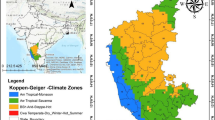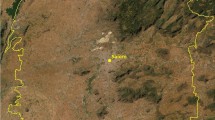Abstract
The Kenyan coast is constantly under persistent cloud cover which hinders mapping using optical images. Up-to-date land-cover information in such areas is sometimes missing from national mapping initiatives. This study uses a computed composite image based on a mean of cloud and shadow free Function of Mask masked multi-temporal Landsat 8 images acquired during long-dry season in a pilot area. We test the effectiveness of the composite to map mangrove forest using random forest (RF) and support vector machines (SVM) machine learning algorithms integrated with context from Markov random fields (MRF(s)). MRFs was chosen because it is computationally efficient hence can be scaled out nationally. The MRF frameworks are compared to pixel-based classification using threefold independent validation samples. SVM–MRFs and RF–MRFs methods have the highest overall accuracy compared to pixel-based classification. However, visual assessment of predicted land-cover using aerial photograghs established that SVM–MRFs framework corresponded well to land-cover in the study area. This framework also managed to map classes with limited ground reference data better than RF–MRFs. Generally, context in both techniques played a discriminative role especially in heterogeneous regions. Therefore, scaling out this approaches would go a long way in generating mangrove forest map inventory in persistent cloud cover regions which is useful for land-based emission estimation.











Similar content being viewed by others
References
Anderson JR, Hardy EE, Roach JT, Witmer RE (1976) A land use and land cover classification system for use with remote sensor data. Development 2001(964):28
Baetens L, Desjardins C, Hagolle O (2019) Validation of Copernicus Sentinel-2 cloud masks obtained from MAJA, Sen2Cor, and FMask processors using reference cloud masks generated with a supervised active learning procedure. Remote Sens 11:433. https://doi.org/10.3390/rs11040433
Barbier EB, Koch EW, Silliman BR, Hacker SD, Wolanski E, Primavera J, Granek EF, Polasky S, Aswani S, Cramer LA, Stoms DM, Kennedy CJ, Bael D, Kappel CV, Perillo GME, Reed DJ (2008) Coastal ecosystem-based management with nonlinear ecological functions and values. Science 319(5861):321–323. https://doi.org/10.1126/science.1150349
Besag J (1986) On the statistical analysis of dirty pictures. J R Stat Soc Ser B (Methodol) 48(3):259–302. https://doi.org/10.2307/2345426
Breiman L (2001) Random forests. Mach Learn 45(1):5–32. https://doi.org/10.1023/A:1010933404324
Bruzzone L, Persello C (2009) A novel context-sensitive semisupervised SVM classifier robust to mislabeled training samples. IEEE Trans Geosci Remote Sens 47(7):2142–2154. https://doi.org/10.1109/TGRS.2008.2011983
Buja K, Menza C (2013) Sampling Design Tool for ArcGIS - Instruction Manual. In: NOAA, Silver Spring, MD
Bunting P, Rosenqvist A, Lucas RM, Rebelo L, Hilarides L, Thomas N, Hardy A, Itoh T, Shimada M, Finlayson CM (2018) The global mangrove watch—a new 2010 global baseline of mangrove extent. Remote Sens 10(10):1669. https://doi.org/10.3390/rs10101669
Candra DS, Phinn S, Scarth P (2017) Cloud and cloud shadow removal of Landsat 8 images using Multitemporal Cloud Removal method. In: 2017 6th international conference on agro-geoinformatics, pp 1–5. https://doi.org/10.1109/Agro-Geoinformatics.2017.8047007
Cao X, Zhou F, Xu L, Meng D, Xu Z, Paisley J (2018) Hyperspectral image classification with Markov random fields and a convolutional neural network. IEEE Trans Image Process 27(5):2354–2367. https://doi.org/10.1109/TIP.2018.2799324
Cao Y, Luo Y, Yang S (2011) Image denoising based on hierarchical Markov random field. Pattern Recognit Lett 32(2):368–374. https://doi.org/10.1016/j.patrec.2010.09.017
Chavez PS (1996) Image-based atmospheric corrections-revisited and improved. Photogramm Eng Remote Sens 62(9):1025–1035
Congalton RG, Green K (2008) Assessing the accuracy of remotely sensed data: principles and practices, 2nd edn. CRC Press, Cambridge
Donato DC, Kauffman JB, Murdiyarso D, Kurnianto S, Stidham M, Kanninen M (2011) Mangroves among the most carbon-rich forests in the tropics. Nat Geosci 4:293
DRSRS (2016) The land cover change mapping program—technical manual. In: Technical report. Directorate of Resource Surveys and Remote Sensing (DRSRS)
Eggleston S, Buendia L, Miwa K, Ngara T, Tanabe K (2006) 2006 IPCC guidelines for national greenhouse gas inventories. In: Technical report. Intergovernmental Panel on Climate Change (IPCC)
FAO (2007) The world’s mangrove forest 1980–2005: a thematic study prepared in the framework of the global forest resources assessment 2005. In: FAO forestry paper, pp 1–77
Foga S, Scaramuzza PL, Guo S, Zhu Z, Dilley RD, Beckmann T, Schmidt GL, Dwyer JL, Hughes MJ, Laue B (2017) Cloud detection algorithm comparison and validation for operational Landsat data products. Remote Sens Environ 194:379–390. https://doi.org/10.1016/j.rse.2017.03.026
Gang PO, Agatsiva JL (1992) The current status of mangroves along the Kenyan coast: a case study of Mida Creek mangroves based on remote sensing. Hydrobiologia 247(1):29–36
Geman S, Geman D (1984) Stochastic relaxation, gibbs distributions, and the bayesian restoration of images. IEEE Trans Pattern Anal Mach Intell PAMI 6(6):721–741. https://doi.org/10.1109/TPAMI.1984.4767596
Gómez-Chova L, Amorós-López J, Mateo-García G, Muñoz-Marí J, Camps-Valls G (2017) Cloud masking and removal in remote sensing image time series. J Appl Remote Sens 11(1):1–15. https://doi.org/10.1117/1.JRS.11.015005
Hagolle O, Huc M, Pascual DV, Dedieu G (2010) A multi-temporal method for cloud detection, applied to FORMOSAT-2, VEN\(\mu \)S, LANDSAT and SENTINEL-2 images. Remote Sens Environ 114(8):1747–1755. https://doi.org/10.1016/j.rse.2010.03.002
Hallahan N, Prepperneau C (2013) Cloud detection and removal techniques for Landsat 8 imagery. In: Technical report. Oregon State University
Hastie T, Tibshirani R, Friedman J (2011) The elements of statistical learning: data mining, inference, and prediction, 2nd edn. Springer. https://doi.org/10.1007/978-0-387-84858-7
Irish RR (2000) Landsat 7 automatic cloud cover assessment. In: Algorithms for multispectral, hyperspectral, and ultraspectral imagery VI. International Society for Optics and Photonics, vol 4049, pp 348–355
Irish RR, Barker JL, Goward SN, Arvidson T (2006) Characterization of the Landsat-7 ETM+ automated cloud-cover assessment (ACCA) algorithm. Photogramm Eng Remote Sens 72(10):1179–1188
Jeon B, Landgrebe DA (1992) Classification with spatio-temporal interpixel class dependency contexts. IEEE Trans Geosci Remote Sens 30(4):663–672. https://doi.org/10.1109/36.158859
Jin S, Homer C, Yang L, Xian G, Fry J, Danielson P, Townsend PA (2013) Automated cloud and shadow detection and filling using two-date Landsat imagery in the USA. Int J Remote Sens 34(5):1540–1560
Kairo JG, Kivyatu B, Koedam N (2002) Application of remote sensing and GIS in the management of mangrove forests within and adjacent to Kiunga Marine Protected Area, Lamu, Kenya. Environ Dev Sustain 4(2):153–166
Karatzoglou A, Smola A, Hornik K, Zeileis A (2004) kernlab-an S4 package for kernel methods in R. J Stat Softw 11(9):1–20. https://doi.org/10.18637/jss.v011.i09
Kasetkasem T, Arora MK, Varshney PK (2005) Super-resolution land cover mapping using a markov random field based approach. Remote Sens Environ 96(3):302–314. https://doi.org/10.1016/j.rse.2005.02.006
Kenduiywo BK, Tolpekin VA, Stein A (2014) Detection of built-up area in optical and synthetic aperture radar images using conditional random fields. J Appl Remote Sens 8(1):83618–83672. https://doi.org/10.1117/1.JRS.8.083672
Kirui KB, Kairo JG, Bosire J, Viergever KM, Rudra S, Huxham M, Briers RA (2013) Mapping of mangrove forest land cover change along the Kenya coastline using Landsat imagery. Ocean Coast Manag 83:19–24. https://doi.org/10.1016/J.OCECOAMAN.2011.12.004
Lafferty JD, McCallum A, Pereira F (2001) Conditional random fields: probabilistic models for segmenting and labeling sequence data. In: Proceedings of the eighteenth international conference on machine learning, Morgan Kaufmann, San Francisco, CA, USA, pp 282–289
Li X, Du Y, Ling F (2014) Super-resolution mapping of forests with bitemporal different spatial resolution images based on the spatial-temporal Markov random field. IEEE J Sel Top Appl Earth Observ Remote Sens 7(1):29–39
Liaw A, Wiener M (2002) Classification and Regression by randomForest. R News 2(3):18–22
Liu D, Kelly M, Gong P (2006) A spatial-temporal approach to monitoring forest disease spread using multi-temporal high spatial resolution imagery. Remote Sens Environ 101(2):167–180. https://doi.org/10.1016/j.rse.2005.12.012
Liu D, Song K, Townshend JRG, Gong P (2008) Using local transition probability models in Markov random fields for forest change detection. Remote Sens Environ 112(5):2222–2231. https://doi.org/10.1016/j.rse.2007.10.002
Lonjou V, Desjardins C, Hagolle O, Petrucci B, Tremas T, Dejus M, Makarau A, Auer S (2016) MACCS-ATCOR joint algorithm (MAJA). In: SPIE 10001, remote sensing of clouds and the atmosphere XXI, Edinburgh, United Kingdom, vol 10001. https://doi.org/10.1117/12.2240935
Loveland TR, Dwyer JL (2012) Landsat: building a strong future. Remote Sens Environ 122:22–29. https://doi.org/10.1016/j.rse.2011.09.022
Mateo-García G, Gómez-Chova L, Amorós-López J, Muñoz-Marí J, Camps-Valls G (2018) Multitemporal cloud masking in the Google earth engine. Remote Sens 10(7):1079. https://doi.org/10.3390/rs10071079
Melgani F, Serpico S (2003) A Markov random field approach to spatio-temporal contextual image classification. IEEE Trans Geosci Remote Sens 41(11):2478–2487. https://doi.org/10.1109/TGRS.2003.817269
Millard K, Richardson M (2015) On the importance of training data sample selection in random forest image classification: a case study in peatland ecosystem mapping. Remote Sens 7(7):8489–8515
Moser G, Serpico SB (2011) Multitemporal region-based classification of high-resolution images by Markov random fields and multiscale segmentation. In: IEEE international geoscience and remote sensing symposium, Vancouver, BC, Canada, pp 102–105. https://doi.org/10.1109/IGARSS.2011.6048908
Neukermans G, Dahdouh-Guebasand F, Kairo JG, Koedam N (2008) Mangrove species and stand mapping in Gazi Bay (Kenya) using Quickbird satellite imagery. J Spatial Sci 53(1):75–86. https://doi.org/10.1080/14498596.2008.9635137
Platt JC (1999) Probabilistic outputs for support vector machines and comparisons to regularized likelihood methods. In: Advances in large margin classifiers. MIT Press, pp 61–74
Qiu S, He B, Zhu Z, Liao Z, Quan X (2017) Improving Fmask cloud and cloud shadow detection in mountainous area for Landsats 4–8 images. Remote Sens Environ 199:107–119. https://doi.org/10.1016/J.RSE.2017.07.002
Richter R, Louis J, Müller-Wilm U (2012) Sentinel-2 MSI—Level 2A products algorithm theoretical basis document. In: Technical reports, vol 49. European Space Agency, Paris
Sanpayao M, Kasetkasem T, Isshiki, Rakwatin P, Chanwimaluang T (2017) A super-resolution land cover mapping based on a random forest and Markov random field model. In: 14th international conference on ECTI-CON, pp 553–556. https://doi.org/10.1109/ECTICon.2017.8096297
Schroeder TA, Cohen WB, Song C, Canty MJ, Yang Z (2006) Radiometric correction of multi-temporal Landsat data for characterization of early successional forest patterns in western Oregon. Remote Sens Environ 103(1):16–26. https://doi.org/10.1016/j.rse.2006.03.008
SLEEK (2019) System for land-based emissions estimation in Kenya. http://www.sleek.environment.go.ke/. Accessed 1 April 2019
Sokolova M, Japkowicz N, Szpakowicz S (2006) Beyond accuracy, F-score and ROC: a family of discriminant measures for performance evaluation. In: Sattar A, Kang BH (eds) AI 2006: Advances in artificial intelligence, Lecture notes in computer science, vol 4304. Springer, Berlin, pp 1015–1021
Solberg AHS (1999) Contextual data fusion applied to forest map revision. IEEE Trans Geosci Remote Sens 37(3):1234–1243
Solberg AHS, Taxt T, Jain AK (1996) A Markov random field model for classification of multisource satellite imagery. IEEE Trans Geosci Remote Sens 34(1):100–113. https://doi.org/10.1109/36.481897
Stehman SV (2009) Sampling designs for accuracy assessment of land cover. Int J Remote Sens 30(20):5243–5272. https://doi.org/10.1080/01431160903131000
Thomlinson JR, Bolstad PV, Cohen WB (1999) Coordinating methodologies for scaling landcover classifications from site-specific to global: steps toward validating global map products. Remote Sens Environ 70(1):16–28
Tiwari LK, Sinha SK, Saran S, Tolpekin VA, Raju PLN (2016) Markov random field-based method for super-resolution mapping of forest encroachment from remotely sensed ASTER image. Geocarto Int 31(4):428–445. https://doi.org/10.1080/10106049.2015.1054441
Tso B, Mather PM (2009) Classification methods for remotely sensed data, 2nd edn. CRC Press, Boca Raton
Vapnik VN (2000) The nature of statistical learning theory. Springer, New York. https://doi.org/10.1007/978-1-4757-3264-1
Young NE, Anderson RS, Chignell SM, Vorster AG, Lawrence R, Evangelista PH (2017) A survival guide to landsat preprocessing. Ecology 98(4):920–932. https://doi.org/10.1002/ecy.1730
Zhu Z, Woodcock CE (2012) Object-based cloud and cloud shadow detection in Landsat imagery. Remote Sens Environ 118:83–94. https://doi.org/10.1016/J.RSE.2011.10.028
Zhu Z, Woodcock CE (2014) Automated cloud, cloud shadow, and snow detection in multitemporal Landsat data: an algorithm designed specifically for monitoring land cover change. Remote Sens Environ 152:217–234. https://doi.org/10.1016/j.rse.2014.06.012
Zhu Z, Wang S, Woodcock CE (2015) Improvement and expansion of the Fmask algorithm: cloud, cloud shadow, and snow detection for Landsats 4–7, 8 and Sentinel 2 images. Remote Sens Environ 159:269–277. https://doi.org/10.1016/j.rse.2014.12.014
Acknowledgements
We wish to thank SLEEK under the Department of Resource Surveys and Remote Sensing (DRSRS) for aerial imagery and Forest2020 under Kenya Forest Service (KFS) for ground reference data. This research was funded by the Australian government through the SLEEK programme facilitated by the Clinton Change Initiative(CCI).
Author information
Authors and Affiliations
Corresponding author
Additional information
Publisher's Note
Springer Nature remains neutral with regard to jurisdictional claims in published maps and institutional affiliations.
Rights and permissions
About this article
Cite this article
Kenduiywo, B.K., Mutua, F.N., Ngigi, T.G. et al. Mapping mangrove forest using Landsat 8 to support estimation of land-based emissions in Kenya. Model. Earth Syst. Environ. 6, 1619–1632 (2020). https://doi.org/10.1007/s40808-020-00778-x
Received:
Accepted:
Published:
Issue Date:
DOI: https://doi.org/10.1007/s40808-020-00778-x




